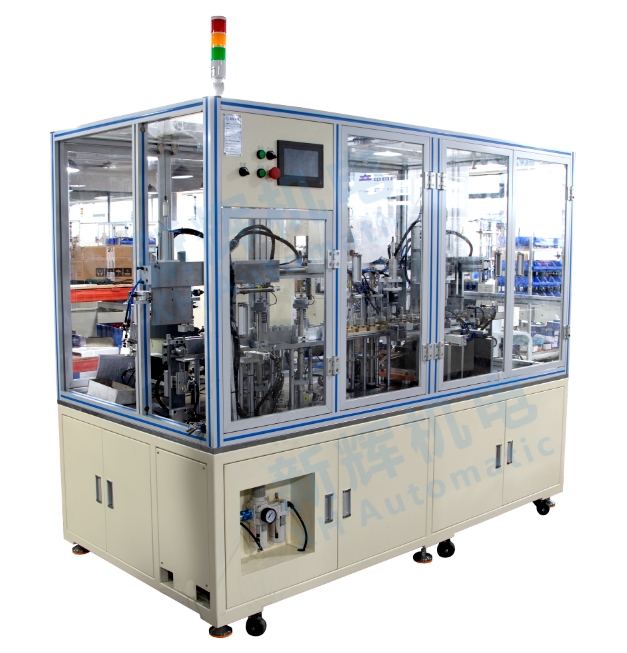What are the common sensor failures and their solutions for DC brushed motor motor fully automatic pressure bearing magnetizing integrated machine?
1、Position sensor failure
l Failure phenomenon
Assembly position deviation: the sensor cannot accurately detect the position of parts, resulting in bearing press fitting or motor assembly position deviation, affecting product quality.
Confusion in the action of the equipment: For example, in the step of press fitting or magnetizing, due to the wrong position signal, the equipment may move ahead or delay the action, resulting in workflow disorder.
l Cause Analysis
Improper installation position: The initial position of the sensor is not well calibrated when it is installed, or it is displaced due to vibration during the operation of the equipment.
Sensor damage: affected by mechanical collision, long-term wear and tear, electromagnetic interference or environmental factors (such as moisture, dust), resulting in damage to the internal components of the sensor, can not work properly.
Connection line problem: Loose, broken, short-circuit or poor contact of the line will make the sensor signal can not be properly transmitted to the control system.

l Solution
Re-calibrate the installation position: Use professional calibration tools and methods to re-adjust the position of the sensor according to the installation manual of the equipment to ensure that it can accurately detect the position of the components. At the same time, check and reinforce the mounting bracket of the sensor to prevent it from shifting again.
Replacing damaged sensors: If the internal components of the sensor are damaged, a new sensor will be required. When replacing, be careful to choose a product with the same model and parameters as the original sensor to ensure compatibility. After replacement, re-calibrate and test.
Check the connection line: Carefully check the connection line of the sensor to see if there is any loose, broken or poor contact. For loose connectors, re-insertion and fixed; for broken lines, need to replace the new wire; for poor contact, you can use a professional cleaner to clean the joints, or replace the joint plug-in.
2、Pressure sensor failure
l Failure phenomenon
Pressure detection error: In the process of pressing the bearing, the pressure value displayed by the pressure sensor does not match with the actual pressure, which may lead to the bearing pressing force is too large or too small.
Equipment Abnormal Alarm: Due to the pressure sensor error signal, the equipment control system may trigger an abnormal alarm to stop the equipment.
l Cause analysis
Sensor zero drift: Long-term use or ambient temperature changes and other factors may cause the zero point of the pressure sensor to drift, making the measured pressure value deviation.
Overload damage: If there is pressure overload during the operation of the equipment, such as excessive resistance in the press-fitting process, the pressure sensor may be damaged.
Signal interference: The surrounding electromagnetic interference or electrical equipment interference, may affect the accuracy of the pressure sensor signal.
l Solution
Zero calibration: According to the instruction manual of the pressure sensor, carry out zero calibration of the sensor periodically. Standard pressure calibration equipment can be used to adjust the zero point of the sensor to the correct position under the specified environmental conditions.
Checking overload protection and replacing transducers: Check that the equipment has a suitable pressure overload protection device, such as a valve or pressure limiter. If not, the appropriate protective device needs to be installed. For pressure sensors that have been overloaded and damaged, it is necessary to replace them with new ones and to check the working conditions of the press-fit system to avoid further overloads.
Anti-interference measures: adopt shielding measures for the signal line of the pressure sensor, such as using shielded cables, and ensure that the shield is well grounded. At the same time, the equipment and may produce electromagnetic interference source to maintain a certain distance, or the source of interference to take shielding, filtering and other measures to reduce its electromagnetic interference with the outside world.
3, magnetic field strength sensor failure (if any)
l Fault phenomenon
Inaccurate magnetizing strength detection: the magnetic field strength after magnetization cannot be measured correctly, resulting in the motor magnetism not meeting the requirements.
Failure of magnetizing control: Based on the wrong magnetic field strength signal, the magnetizing equipment may not be able to magnetize according to the predetermined strength, affecting product quality.
l Cause Analysis
Sensor aging or damage: After long-term use, the sensitive components of the magnetic field strength sensor may age, degrade in performance, or be damaged due to, for example, impact by a strong magnetic field.
Calibration problem: The sensor is not calibrated regularly, resulting in inaccurate measurement results.
Environmental magnetic field interference: Other magnetic field sources around the equipment (such as other motors, transformers, etc.) may interfere with the measurement of the magnetic field strength sensor.
l Solution
Replace or repair the sensor: For aging or damaged magnetic field strength sensors, you need to replace the sensor with a new one or repair it. When choosing a new sensor, pay attention to its measuring range, accuracy and other parameters in line with the equipment requirements.
Regular calibration of the sensor: in accordance with the specified period and method, the use of standard magnetic field strength calibration equipment to calibrate the sensor to ensure the accuracy of its measurement.
Reduce environmental magnetic field interference: Evaluate the magnetic field environment around the equipment and try to minimize the interference of other magnetic field sources on the sensor. Magnetic field shielding materials can be used to shield the sensor, or adjust the layout of the equipment, so that the magnetic field strength of the sensor away from other magnetic field sources.
※ If the above ways and means still can not solve the equipment failure, please contact Xinhui Electromechanical Equipment Co., Ltd. technical specialists through the page chat tool to seek help.







